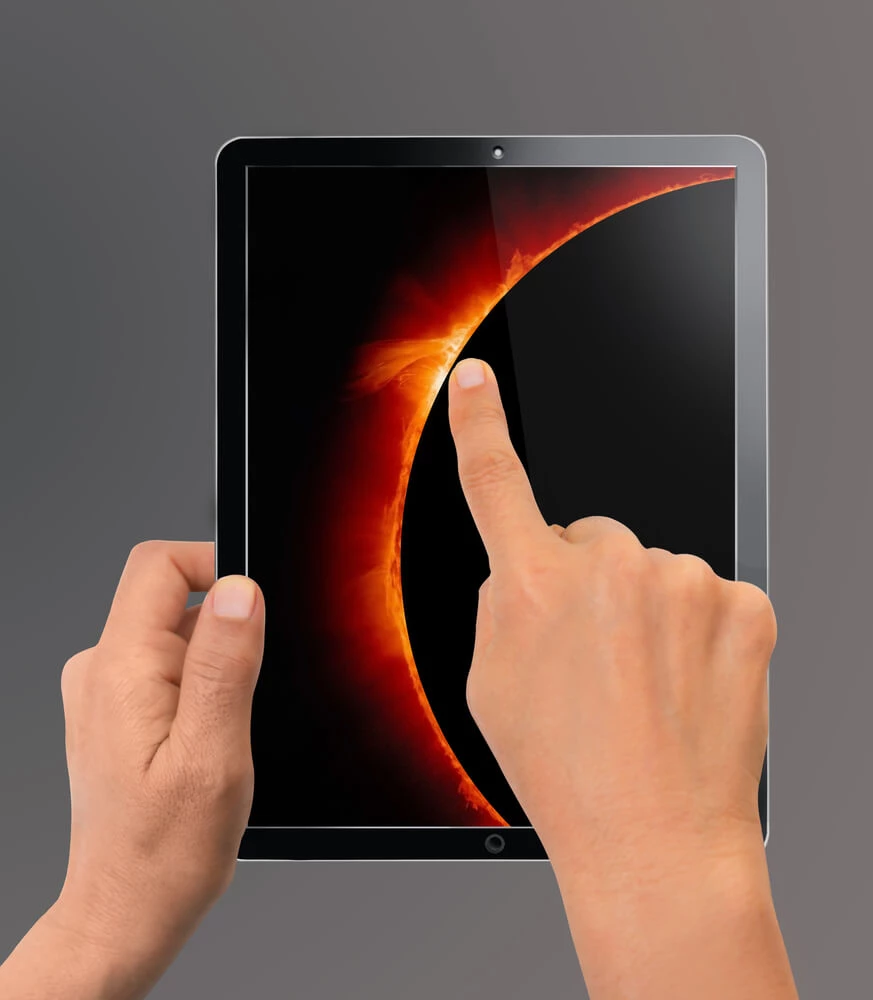Solar eclipse photography tips

- Photography tips for solar eclipse:
- 1. Book best location to make photo
- 2. Try not damage the camera
- 3. Check all digital devices to bring
- 4. Use right camera settings
- 5. Try to take several shots
- 6. Compose best solar eclipse photos in advance
- 7. Avoid dangerous moments
- 8. Edit images during post-processing
The main astronomical event is considered to be a Total Solar Eclipse. It is a shadow of the moon on the surface of Earth. This contour in diameter is about 200 km, which is many times smaller than the diameter of Earth. Therefore, this magnificent and rare event can be observed simultaneously only in a narrow strip on the path of the lunar profile.
If the observer is located in a dark silhouette, he sees a total solar obscuring, when the moon completely hides the sun. At the same time the sky darkens, and stars can become visible. Birds fall silent, frightened by the sudden darkness, and try to hide.
Observers located near the total darkening line can see a partial phenomenon. In this case, the moon passes across the sun, not exactly in the center, but hides only a part of it. In this case, the sky darkens a little and stars are not visible. It can be observed at a distance of about 2 thousand kilometers from the zone.
There are many articles on how it influences geopolitical trends, new cycle sets, global processes that affect destinies of states, nations, collapse of political systems and revival of social values. But in this article we will talk about how to photograph the solar eclipse and memorize this magic moment, using a great chance to practice and enjoy.
The key factor to complete this important mission is to choose the right camera settings. But, first of all, safety preparations which are essential in such a dangerous activity. After all, a famous sarcastic joke is not a joke at all because it says: “You can see solar hiding with a naked eye only twice: first, with the right eye, then with the left one”. Ultraviolet radiation can burn the retina and cause irreversible eye damage and even blindness.
Therefore, it is important to use eye protection:
- solar filters and films (it can be purchased at optical equipment stores and fixed on telescopes, glasses or binoculars)
- special glasses
- welding goggles
- film for cameras
- or film from an old (5.25 ") floppy

Photography tips for solar eclipse:
- Use polarization or neutral gray light filters (ND filter). ND filters come in various densities (varying degrees of darkening), but even the strongest (ND-1000) do not provide adequate protection
- Try to combine several filters all together, which considerably reduce solar radiation
- Use a special solar filter that you can do yourself or purchase. Such a filter can reduce light effect by 100,000 times, which ensures an adequate level of security for the matrix and your eyes

What else you need to photograph solar eclipse:
1. Book the best location to make photo
2. Try not damage the camera
3. Check all digital devices to bring
4. Use right camera settings
5. Try to take several shots
6. Compose best solar eclipse photos in advance
7. Avoid dangerous moments
8. Edit images during post-processing
Steady tripod is always a must for such kinds of pictures, especially when such a significant event has to be captured. Every motion can spoil the final result, so ensure that your camera is fixed well. If you are going to publish a normal size image, then a good lens with a large focal length starting from 100 mm is required. Be aware that the usual wide angle lens is not appropriate for this occasion, because the sun is going to seem a small dot on the picture. Wide angles have to be used only together with special extenders. Think of additional requests, when inner and outer sun corona have to be captured. Such pictures require specific adjustments.
1. Book best location to make photo

When you think you have everything you are going to need, get online to watch the best location to shoot. Due to a unique event many hotels and guesthouses promote their services being geographically well-located for photographing solar eclipse. Other cities and landscapes are good as well, but the effect is not going to be so significant and memorable. So book a nice place for you and friends. Travelling together with an interesting mission will contribute to getting best results. Watch various videos to learn other photo tricks and pray for cloudless sky. Making pictures in a form of diagram showing the movement of the moon across the sun is always a good idea.
2. Try not damage the camera

There is nothing so easy as burning something focusing sunlight through a magnifying glass. Photographic lenses (especially telephoto lenses) will work in the same way. It will focus the light on the camera's matrix, just like a magnifying glass on a piece of paper. Of course, you will not make a hole in it, but it can be easily disabled! This is especially dangerous for compact cameras, where the lens constantly projects an image onto a matrix.
Let us not forget that the camera matrix is a photosensitive element, so that a solar obscuring can "blind"it. That is why think well before looking above though a viewfinder of your digital device. This action may cause not only health but also financial damage, due to significant expenses afterwards.
3. Check all digital devices to bring

It is better not to neglect the importance of checklists, because natural phenomena like this do not happen often. Therefore make sure that everything you need is clean and ready to be used. Memory cards and extra batteries are essential if you do not want to miss such a splendid moment of taking photos of solar eclipse. Think of a possibility to use remote control and charge it as well. Only planning can guarantee satisfaction from organized hard work.
4. Use right camera settings

Usually manual mode is the best option, but certain settings are obligatory for successful results:
- choose always RAW format;
- minimum value for ISO;
- aperture f / 8;
- minimum shutter speed (better if it is 1/8000).
These recommendations are only to begin, because after that you will definitely need to check if there is some other change to be done to become even more effective. Every detail makes the difference for the photographer.
Ideally, it is worth taking into consideration specific weather conditions: cloudy weather is going to cover all the beauty, and even the perfect plan will fail. But the weather with few clouds will give a chance to make a beautiful frame. Still, for observation of this phenomenon clear sky is more appropriate.
5. Try to take several shots

Remember that during sun darkening you may need to increase your exposure.
- If the frame is overexposed, reduce shutter speed and / or increase aperture value.
- If the frame is underexposed, increase shutter speed or decrease aperture value.
6. Compose best solar eclipse photos in advance

Decide beforehand with techniques, plot and emotion of an image, perspective and composition. Think about how your picture have to look like:
- Use the rule of thirds, do not place the sun in the center.
- Take a picture of people watching this phenomenon.
- Show what kind of eye protection people use, emotions on their faces and other ideas your imagination will suggest.
- Make a picture of phenomenon reflection in a water puddle or pond (it is not only creative, but safer for both eyes and camera).
- Find a suitable place outdoors: park, preferably not too close to skyscrapers and multistoried buildings.
7. Avoid dangerous moments

Do not point the camera at the sun for a long time. Shoot quickly, moving it to the side.
Do not use long exposures (longer than 1/30 s). First of all, it is useless, and you will most likely get a very overexposed frame. Secondly, the longer the shutter speed, the more time the camera will face intense sunlight.
Real danger is guaranteed for tele-lenses. Long focal lengths expose equipment and eyes to intense, so the risk of damage increases.
Do not buy cheap darkening filters. Choose another mode to save money. Destroying equipment and missing a magic moment will cost you much more regrets.
8. Edit images during post-processing

Most fantastic snapshots are usually realized with the help of retouching programs. It is a simple, free and comfortable way to reduce the number of errors and increase desirable effects. Plenty of functions offer users a wide range of changes to apply. Processing images online provides necessary skills for the future. Interactive software is capable of examining and improving tiny picture details, which are not visible to a human’s eye. The quality of these applications permit diy creation of fantastic masterpieces from a simple phone image.
One may consider this article to be a very complicated tutorial, but we are sure that only preparation and practice can help in the search of great pictures. In case if this fun guide did not convince you to be ready for solar eclipse photography, there is always another splendid option.

If you decided to simply shoot people around, it would be better to make sure that the flash does not interfere with their activity. Still, methodically clicking the camera waiting for a successful shot, it is important to take a break for a few seconds and just look at the fantastic sun corona and enjoy it.
Without all above-mentioned tricks, you can shoot sunrise or sunset, when it is almost close to the horizon. The light is not so intense, and very beautiful. No wonder that photographers all over the world are so fond of such shooting! Get your imagination work and impress public opinion with personalized artistic taste and vision of ordinary and extraordinary events and objects.
Co-founder of RetouchMe. In addition to business, he is passionate about travel photography and videography. His photos can be viewed on Instagram (over 1 million followers), and his films can be found on his YouTube channel.
Moreover, his profile is featured on the most popular and authoritative resource in the film industry — IMDb. He has received 51 international awards and 18 nominations at film festivals worldwide.

with RetouchMe














